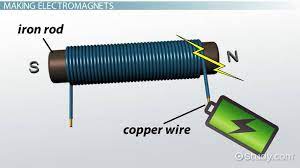We definitely realize that an electric flow can possibly create an attractive field in a plane that is opposite to the heading of the flow stream. But do not miss to check out the numerous uses of electromagnets before starting with this article. The electromagnet utilizes this guideline. An electromagnet can be characterized as a magnet that follows up on power. In contrast to a lasting magnet, the force of an electromagnet can be changed by changing the measure of electric flow that moves through it. On the off chance that the current stream is removed, the attraction property stops existing.

In any case, this is likewise a benefit of an electromagnet over a lasting magnet on the grounds that controlling the electric flow additionally controls the attractive field, for this situation, that is, the strength of the electric field likewise controls the strength of the attractive field. Indeed, the post of an electromagnet can likewise turn around the progression of power.
What Is An Electromagnet?
Electromagnets are made of a solitary wire of wire (twisting in a wire chain). It is more powerful in making an attractive field than a straight-moving wire. This impact can be supported by firmly curving a wire around an amazing center, like an attractive material, like iron. The photograph above shows the curl twisted around an iron nail. All alone, an iron nail isn’t attractive.
Magnet Properties
A few properties of the magnet are as per the following:
- Attractive property – ferromagnetic materials like iron, nickel, and cobalt are pulled in by magnets
- Repulsive property – as shafts repulse one another while posts pull in one another
- Instructional property – An autonomously suspended magnet consistently focuses the north-south way
Working Standard Of Electromagnets
So how do electromagnets function? Allow us to think about the iron nail itself. For what reason does it not produce an attractive field when it isn’t influenced by an electric field?
An iron nail is framed in a magnet by passing an electric flow around the magnet.
For the most part, the molecules in the nail are situated in arbitrary ways and the individual attractive fields drop one another. Affected by electric flow, these particles are restarted to point a similar way.
There are two basic kinds of magnets: perpetual magnets and electromagnets. Perpetual magnets contain a mix of iron, cobalt, and nickel metals, which produce a steady attractive field. Subsequently, these magnets won’t ever adhere to your refrigerator. Electromagnets, interestingly, produce an attractive field through an electric flow. At the point when the electric flow stops, that attractive field is obliterated.
Resistive
- A resistive magnet makes an attractive field with copper wires. As the power travels through the wire, the electrons produce a frail attractive field. At that point, in the event that you pivot a wire around a piece of metal, like an iron, you help to base that attractive field on the iron. The more you twist the wire, the more grounded the region.
- You can likewise utilize a pile of copper plates, normally unpleasant plates. Named after their creator, Francis Bitter, there are openings in the severe plates that permit water to go through and cool the magnets, permitting the magnets to deliver a solid attractive field. On the disadvantage, it takes an exorbitant bit of power and water to keep these resistive magnets on.
Superconductors
- Superconducting electromagnets work by lessening electrical opposition: while a flow travels through the copper plate, the iotas in the copper meddle with electrons in the electric flow. In this manner, superconducting magnets utilize fluid nitrogen or fluid helium to deliver freezing temperatures. The virus keeps the copper particles out, and these electromagnets will keep on working in any event, when the force is killed.
- According to the Magnet Lab of Florida State University, superconducting electromagnets have huge potential. Starting in 2010, researchers are utilizing them to improve innovation for clinical imaging and to create suspending trains.
Hybrid
- Hybrid electromagnets consolidate resistive electromagnets with superconducting electromagnets. Mixture electromagnets change in plan, yet at Florida State University’s Magnet Lab, the crossover weighs 35 tons, is in excess of 20 feet tall, and has sufficient copper wire for 80 normal homes. Deionized water, or water without electric charge, keeps this crossover magnet up to 400 degrees Fahrenheit beneath edge of freezing over.
- Lawrence Berkeley National Laboratory likewise creates crossover electromagnets. In January 2010, researchers there built up another kind of crossover for atomic exploration.

As the editor of the blog, She curate insightful content that sparks curiosity and fosters learning. With a passion for storytelling and a keen eye for detail, she strive to bring diverse perspectives and engaging narratives to readers, ensuring every piece informs, inspires, and enriches.









